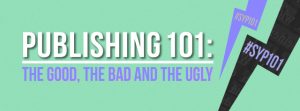Last Thursday we welcomed Vikki Reilly from Birlinn Books, one of Scotland’s leading independent publishers. The talk covered her experience working in a sales team, getting into the publishing industry, and advice about internships.
Birlinn and being part of the Sales team
Although Birlinn are a fairly small publisher with a team of around 20 employees, they punch significantly above their weight, publishing around 160 titles a year. One of their more distinguishing features is that they proudly publish books that tell the stories of all of Scotland – not just the central belt. This leads to a more national conversation, which can only benefit the book industry in Scotland.
Vikki works specifically in the sales department, and provided us with some valuable insight into working in this sector:
- Nurture your relationships with booksellers.
- Be trustworthy – people can tell when you’re lying.
- Know what market a book sells best in.
- The best way to sell a book is face-to-face, and sales teams are developing more now as publishers begin to recognise this (hooray!).
Getting into the industry
Vikki talked us through her experience of getting into the publishing industry, including completing the MLitt in Publishing Studies at Stirling University and interning for several publishers, including Canongate. But her presentation emphasised that it is crucial to expand your frame of reference. One of her main pieces of advice was to “never underestimate what you can learn on a shop floor.” Taking on jobs in music shops and bookstores is useful, and will enhance your ability to relate to other people’s interests, which is useful in publishing. Additionally, her presentation stressed that people rarely have a singular career path in publishing now, so be flexible and don’t let good opportunities pass you by.
Internships
Birlinn offer an internship programme where interns spend 3 months at a time with them, and Vikki informed us that they have a space coming up in April. During these 3 months interns can get the most out of the experience and gain new skills. Vikki offered some useful advice for all the existing and future interns out there:
- Don’t go in there with a sense of entitlement, (there’s nothing wrong with making a cup of tea occasionally).
- While it can be difficult, try not to be too shy! You will get more from your experience by asking questions and being enthusiastic – people like it when you take an interest.
- Remember that everyone is still learning, not just you. Meaning, no question is too stupid (this was definitely
 reassuring to hear).
reassuring to hear).
At the end of the presentation we were provided with lovely catalogues of Birlinn’s titles as of 2016 (and cake). Overall, the presentation was lively and engaging, and I think most people left the room feeling really inspired.
– by Rachel Patrick













